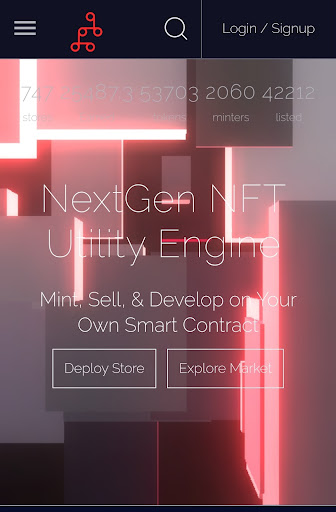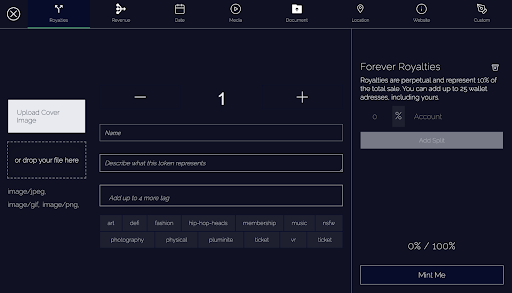What is Mintbase?
Mintbase is a platform that allows anyone to create their own NFT store. Once a store has been created, users can mint, then sell or auction their creations. Mintbase provides an environment where users can create NFTs without necessarily having the technical knowledge to do so.
Users can mint a vast range of assets, including files, music, event tickets, art, pictures and so on. After minting NFTs, users can set them as “For Sale” on NFT marketplaces such as OpenSea or within their own store on Mintbase.
Mintbase calls itself the Shopify of NFTs due to the ease of creating and selling items. The Lisbon, Germany-based platform is the brainchild of Nate Geier and Caroline Wend.

What are NFTs in Mintbase?
NFTs refer to non-fungible tokens. Traditional money, such as the US dollar and cryptocurrencies, are fungible in that they can be exchanged for another. If someone gives you a $20 bill, that bill is just like, and equal to, any other in your possession.
Non-fungible tokens are a different proposition. Each one is unique and can’t be interchanged or replaced with another. An NFT has been ascribed metadata that makes it unique from any other token. Mintbase automates the creation of these NFTs on either Ethereum or NEAR. NFTs cannot be created simultaneously on both platforms, although users are free to manually mint them on both blockchains.
Mintbase was first launched on Ethereum, but rising gas fees made minting and purchasing rather expensive for the average user. The launch and integration of NEAR has allowed the process of creating a store and populating it with your NFTs to become much more accessible to creators.
How does Mintbase work?
Mintbase aims to provide anyone everywhere with the ability to create and sell NFTs even if they don’t have the skill to do so. Originally the technical barrier to creating NFTs was quite high, as you needed to know about launching smart contracts. This is exactly what Mintbase helps with. Each store is itself a smart contract that can be deployed with a couple clicks of a button.
Minting NFTs
Any digital good of your choosing can be turned into an NFT and sold in your store. Mintbase offers a multitude of options for customising your NFT. For example, creators can decide to give a royalty to any account they like in perpetuity. Any time that NFT is sold in the future, it will send a percentage (decided by the creator) to an account of their choosing.

Additionally, any and all metadata may be attached to the NFT, such as a website, date or location. If none of this kind of metadata suits your needs for your NFT, you have the ability to create custom metadata as “key value pairs”. An example of this might be if you’re creating an NFT sword to be used within a game. The metadata might look something like “strength: 6, speed: 4” and so on.
Selling NFTs
Once you have created the NFTs, you are free to list them as “For Sale”, or auction them off to buyers. After being listed, buyers can browse the store front and see which NFTs you are willing to sell. They are able to either purchase the NFTs outright, or bid on them within the auction you’ve set up. Within the auction, owners of the NFT have the ability to accept or reject the bids made on the NFT. When an NFT is sold, Mintbase charges a fee of 2.5% when you sell an NFT from your store. All other royalties you may have set up are distributed automatically to their respective accounts.
What token do I need to use Mintbase?
Mintbase runs on both the Ethereum blockchain and the NEAR protocol. The NEAR token serves as a unit of value on the NEAR network, and the same goes for ETH on Ethereum. Mintbase is compatible with both blockchains, but not simultaneously. So if you choose to use eth.Mintbase.io, then you will be paying fees in ETH. If you choose to use mintbase.io, then you will be paying fees in NEAR.
Where can I buy NEAR?
The NEAR token is listed on Binance, OKX, Huobi Global, Crypto.com, and many others. Check CoinMarketCap for a complete list of exchanges that offer the ability to buy NEAR.
Which wallet can I use to manage my NEAR?
You can manage your NEAR using the NEAR wallet or Ledger hardware wallet. To sign up for NEAR wallet, go to wallet.near.org and click “Create Account”. You will need to write down a 12-word phrase as the online wallet is non-custodial. This ultimately means that you retain complete ownership over your NEAR, as well as any stores or NFTs created using your account.
Where can I buy ETH?
Being one of the most popular cryptocurrencies, there’s no shortage of places to grab some ETH. Some of the top exchanges include Binance, Coinbase, Huobi, Coinmama, Crypto.com, Gemini, Kraken and more. ETH can be traded with a wide range of cryptocurrencies and the biggest stablecoins.
Which wallet can I use to manage my ETH?
ETH is supported by many trusted wallets. Some include MetaMask, MyEtherWallet, Ledger, Trezor and Exodus. Consider using a hardware wallet, which is offline and protects your ETH from online vulnerabilities such as hacks and phishing. For the most simple interaction between Mintbase and an Ethereum wallet, a browser wallet like MetaMask is a great option.
How to use Mintbase
Creating a store
In Mintbase, a store is a smart contract that is like your own company. A store allows you to mint NFTs, sell or auction them, and then burn them should you choose to do so. To create a store, follow these steps:
- Click “Log in” if you already have an account and “Sign up* if you don’t have an account yet.
- Connect a wallet.
- The NEAR wallet, MetaMask, Coinbase Wallet, Trust Wallet, Fortmatic, Wallet Connect, and Argent are examples of wallets that can be integrated with Mintbase.

- Click on “Create Store” on the Mintbase interface. You can create several stores.
- Name your store. Then, click “Create Contract”.
- Confirm gas fee. This is the amount that Ethereum deducts for transaction fees. If you don’t already have ETH in your wallet, you can purchase some from exchanges such as Binance, Coinbase, Kraken, etc.
- Wait for the process to take place and for you to be redirected to Mintbase’s interface.
Selling NFTs
Users can mint NFTs and sell them on OpenSea. When you enter the price for a newly minted token, you can list it as “For Sale”. You can even send out a link of the posting to social media platforms for people to see it. People that already have MetaMask, Coinbase Wallet or the NEAR wallet can purchase your NFTs in just 2 clicks.
eth.Mintbase.io versus Mintbase.io
Mintbase runs on Ethereum and the NEAR protocol. However, there’s an inclination towards NEAR than Ethereum. Here are some differences between the 2 platforms:
Fees
Minting on Ethereum is much more expensive than NEAR for a number of reasons. The predominant reason is that Ethereum has many more users interacting with the platform, driving up demand for block space, and thus the fee to have your transaction included in a block. ETH2.0 is said to fix the high fees on Ethereum, but until it’s release (estimated to be 2022), NFTs may be minted for a much cheaper price on NEAR.
A single transaction on Etheruem can cost up to USD $100. By contrast, minting up to 10 NFTs on NEAR can cost just USD $$0.01. Mintbase developers have advised users against minting on Ethereum for that reason.
More guides on Finder
-
How to make money with NFT games
Play, trade and earn with blockchain games. Here are 10 ways to make money with NFT gaming.
-
Top NFT metaverse worlds
Discover what NFT metaverses actually are and which projects are leading the way in this digital ecosystem.
-
Top metaverse projects
Keep an eye out for the most promising metaverse projects. Here are the top general and game-focused metaverse projects to watch.
-
NFT trading cards: What they are and how they work
NFT trading cards are similar to trading cards in real life. It’s a large, profitable niche – especially in the gaming sphere.
-
NFT designs
Not everyone is an artist but anyone can mint an NFT. Here’s where to look for in NFT designers, what it may cost and what to watch out for.
-
NFT avatars
Avatars aren’t anything new, but NFT avatars are different. Here’s how they work, how and where to buy one, and what makes them valuable.
-
Top crypto games
Discover the latest and most popular GameFi titles, project details, upcoming launches and more in this comprehensive crypto game list.
-
Star Atlas review
Conquer the Star Atlas metaverse and earn value in this blockchain-based play-to-earn game based in the year 2620.
-
NFT statistics
The definitive ranking of the NFT adoption across 26 countries.
-
How to make NFTs
Find out what you need to create your own NFTs. We walk you through a step-by-step process for how to mint and then sell your own NFT.